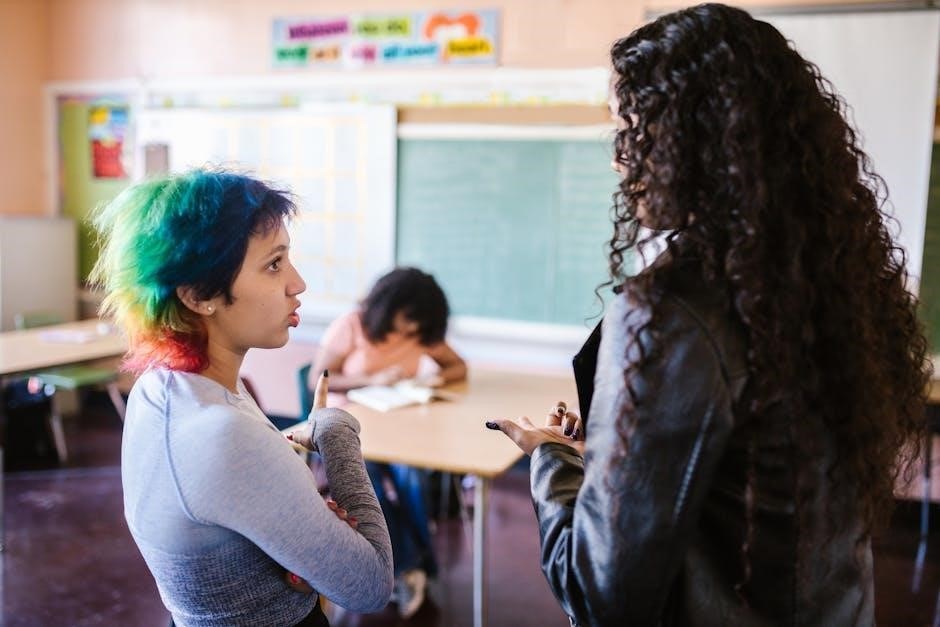Vocabulary development is crucial for middle school students‚ enhancing reading comprehension‚ communication‚ and academic success. Engaging activities like word games‚ collaborative projects‚ and interactive exercises foster meaningful learning and retention.

1.1 Importance of Vocabulary Building for Middle School Students
Vocabulary building is essential for middle school students as it enhances reading comprehension‚ communication skills‚ and critical thinking. A robust vocabulary supports academic success across subjects‚ enabling students to understand complex texts and express ideas effectively. It also fosters confidence in language use‚ preparing them for high school and beyond. By engaging in activities like word games and collaborative projects‚ students develop a stronger foundation for lifelong learning and better academic outcomes. Vocabulary mastery is a cornerstone of education‚ equipping students with the tools to succeed in various disciplines and real-world scenarios.
1.2 Challenges in Teaching Vocabulary at the Middle School Level
Teaching vocabulary at the middle school level presents unique challenges‚ including varying student proficiency levels and limited time for instruction. Many educators lack structured programs‚ leading to inconsistent vocabulary teaching. Additionally‚ traditional methods like dictionary definitions often disengage students‚ making retention difficult. Effective vocabulary instruction requires creative approaches to cater to diverse learning styles and maintain student interest. Balancing depth of word knowledge with breadth of vocabulary is another challenge‚ as is assessing mastery without relying solely on rote memorization. Addressing these issues is crucial to ensure students develop a strong‚ functional vocabulary that supports their academic and personal growth.

Effective Strategies for Teaching Vocabulary

Effective vocabulary instruction involves pre-teaching‚ word associations‚ and brain-based activities. These methods engage students‚ promote retention‚ and foster a deeper understanding of word meanings and usage.

2.1 Pre-Teaching Vocabulary: A Structured Approach
Pre-teaching vocabulary is a proven method to introduce new words systematically before they appear in texts. This approach ensures students grasp meanings and usage through structured activities. Teachers often use word lists‚ definitions‚ and examples to familiarize students with key terms. Activities like matching games‚ crossword puzzles‚ and word sorting help reinforce learning. Pre-teaching also involves discussing synonyms‚ antonyms‚ and word origins to deepen understanding. By focusing on high-utility words‚ educators equip students with a strong foundation for reading and writing. This method is particularly effective for middle school students‚ as it bridges gaps in prior knowledge and builds confidence in tackling complex texts.
2.2 Using Word Associations and Context Clues
Word associations and context clues are powerful tools for vocabulary development. By connecting new words to familiar ones‚ students build mental links that enhance retention. Context clues‚ such as surrounding words or sentences‚ help students infer meanings independently. This strategy fosters critical thinking and reduces reliance on dictionaries. Teachers can encourage group discussions where students share associations and analyze contexts. Activities like word mapping and sentence completion further engage learners. For example‚ pairing words with images or synonyms strengthens understanding. This approach not only deepens comprehension but also prepares students for real-world reading scenarios. It’s a practical‚ interactive way to make vocabulary learning meaningful and lasting.
2.3 Brain-Based Vocabulary Activities for Engagement
Brain-based vocabulary activities engage students by leveraging how the brain naturally learns. Techniques like movement‚ visuals‚ and repetition enhance retention. Activities such as word charades‚ where students act out vocabulary‚ or creating visual word maps‚ tap into multiple senses. Collaborative games like “Word Memory Match” or “Vocabulary Bingo” foster engagement and teamwork. Incorporating music or rhymes further activates memory pathways. These methods align with how the brain processes information‚ making learning interactive and enjoyable. By integrating physical and creative elements‚ teachers can ensure that vocabulary lessons are both effective and memorable for middle school students.

Interactive Vocabulary Activities for the Classroom
Interactive activities like word games‚ collaborative projects‚ and tech-based lessons create engaging vocabulary practice. These methods encourage participation‚ teamwork‚ and fun‚ fostering deeper understanding and retention;
3.1 Word Games and Competitions to Reinforce Learning

Word games and competitions are dynamic tools for reinforcing vocabulary. Activities like crossword puzzles‚ word searches‚ and online quizzes make learning interactive and fun. Competitions such as vocabulary bees or team-based games encourage healthy rivalry and teamwork. These exercises not only enhance retention but also build confidence in using new words. Teachers can incorporate digital tools like Kahoot! or Quizlet for engaging virtual sessions. Additionally‚ traditional games such as Scrabble or Boggle adapt well to classroom settings. By integrating these activities‚ educators create a lively environment where students actively participate and enjoy the process of expanding their vocabulary.
3.2 Collaborative Projects and Group Work
Collaborative projects and group work are effective strategies for vocabulary development. These activities encourage students to work together‚ fostering teamwork and a deeper understanding of word meanings. Assignments such as creating word posters‚ skits‚ or group presentations allow students to apply vocabulary in context. Group discussions and peer teaching also enhance retention and communication skills. By engaging in these shared tasks‚ students not only learn from one another but also develop critical thinking and creativity. Collaborative efforts make vocabulary learning interactive and enjoyable‚ ensuring that students are actively involved in the learning process.
3.3 Integrating Technology for Interactive Vocabulary Lessons
Technology offers innovative ways to make vocabulary lessons engaging and interactive. Tools like Google Jamboard and Kahoot! enable dynamic word games and quizzes‚ fostering competition and active participation. Interactive PDF worksheets and digital flashcards allow students to practice independently. Multimedia resources‚ such as videos and slideshows‚ provide visual and auditory learning experiences. Additionally‚ collaborative platforms like Padlet or Google Docs can facilitate group work and peer discussion. These digital tools not only enhance student engagement but also cater to different learning styles‚ ensuring a comprehensive and enjoyable vocabulary-building experience for middle school students.

Assessment and Feedback in Vocabulary Instruction
Effective vocabulary instruction requires ongoing assessment and constructive feedback to track student progress and understanding‚ ensuring tailored support and improved learning outcomes.
4.1 Creative Ways to Assess Vocabulary Mastery
Creative assessments engage students and provide deeper insights into their vocabulary understanding. Tools like crossword puzzles‚ word searches‚ and interactive quizzes offer fun ways to evaluate mastery. Technology-based platforms such as Kahoot! and Quizlet enable dynamic‚ real-time assessments. Project-based evaluations‚ such as creating infographics or skits using target words‚ encourage application of knowledge. Collaborative activities‚ like group presentations or vocabulary charades‚ foster teamwork while assessing comprehension. These methods go beyond traditional tests‚ allowing teachers to gauge students’ ability to use vocabulary in context effectively. Such approaches ensure comprehensive evaluation and cater to diverse learning styles‚ making assessment both meaningful and enjoyable for middle school students.
4.2 Providing Constructive Feedback to Students
Constructive feedback is essential for helping students improve their vocabulary skills. Teachers can provide specific‚ timely‚ and clear comments on assignments‚ highlighting correct usage and gently correcting errors. Positive reinforcement encourages students to continue learning‚ while actionable suggestions guide them toward improvement. For example‚ instead of saying “incorrect‚” a teacher might explain‚ “This word is a noun‚ but in this sentence‚ we need a verb. Try using ‘run’ instead of ‘runner.'” Offering choices‚ like selecting a word to define or use in a sentence‚ allows students to take ownership of their learning. This approach fosters growth and confidence‚ making feedback a valuable tool for vocabulary mastery.

PDF Resources for Vocabulary Activities
Downloadable PDFs offer versatile vocabulary tools‚ including worksheets‚ lesson plans‚ and exercises tailored for middle school students to enhance word knowledge and engagement effectively.
5.1 Downloadable Worksheets and Lesson Plans
Downloadable PDF worksheets and lesson plans provide structured activities for middle school vocabulary development. These resources include word lists‚ definitions‚ and exercises tailored to various learning levels. Teachers can access comprehensive lesson plans that integrate vocabulary building with other subjects‚ ensuring a holistic approach. Interactive elements‚ such as fill-in-the-blank exercises and crossword puzzles‚ engage students and reinforce word retention. Additionally‚ these PDFs often include assessment tools to track progress. They offer flexibility‚ allowing educators to adapt activities to meet specific classroom needs. With a focus on practical application‚ these resources enhance both teaching efficiency and student understanding of vocabulary concepts.
5.2 Vocabulary Lists and Exercises for Middle School Level

Vocabulary lists and exercises tailored for middle school students are essential tools for structured learning. These resources often include word definitions‚ sentences‚ and exercises that cater to diverse learning levels. Many lists align with educational standards‚ such as the Common European Framework of Reference (CEFR)‚ ensuring relevance and progression. Exercises like matching games‚ fill-in-the-blanks‚ and sentence completion help reinforce word meanings. Additionally‚ thematic lists cover topics like daily routines‚ school subjects‚ and social studies‚ making learning contextually engaging. These exercises are designed to enhance retention and application‚ allowing students to use new words confidently in various contexts. They also support cross-curricular integration‚ making them versatile for different subjects and teaching approaches.